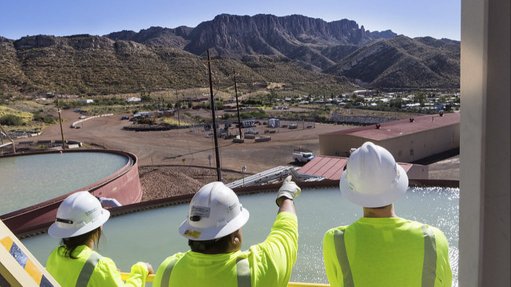Engagement with govt key in indigenisation legislation
Free, open and honest engagement between investors and the Zimbabwe government – sooner rather than later – is key to moving forward with the country’s indigenisation legislation, as keeping the lines of communications open will create a win-win solution for both parties, law firm Webber Wentzel Africa mining and energy partner Bruce Dickinson tells Mining Weekly.
The Indigenisation and Economic Empowerment Act that was signed into law in 2008 aims to transfer the country’s mineral wealth to indigenous Zimbabweans and each foreign mining company operating in Zimbabwe is required to sell a 51% stake of its operations to locals.
Clarity on whether or not mining companies will be able to sell the 51% stake at market value or whether the ruling party, Zanu-PF, will persist in its drive towards transferring the 51% interest for low or no value is critical.
“Companies and investors that are active in Zimbabwe need to engage with government and its Ministries on the economics of the projects, while consulting with one another on the original indigenisation plans that were approved from 2011 onwards to clarify issues that may stem from this,” says Dickinson.
He maintains that, while Zimbabwe has investment opportunities in its significant natural resources, a mostly well-educated popu- lation and access to the necessary, although deteriorating, infrastructure, there is significant potential for developing the country’s resources, provided the mining environment is made more conducive to investment.
Dickinson notes that the clear lack of certainty in terms of a balanced set of laws that encourages investment has resulted in a sense of frustration among investors. “Once this is dealt with, investment should flood in,” he says.
When the mining indigenisation regulations were first introduced in Zimbabwe in 2011, they halted deal flow immediately, resulting in the country becoming less attractive for investments.
However, after some time, investors started to understand the principles and ideas behind the mining indigenisation regulations, which led to economically viable and sustainable structures being developed, which complied with the mining indigenisation regulations, and which could be implemented by the mining industry. This led to deal flow regaining some traction in Zimbabwe.
During this period, Webber Wentzel dealt with two main categories of clients – those who had already invested in the mining industry of Zimbabwe, with which the firm worked to design and implement deal structures, and those wanting to invest, who were prepared to invest in high-risk destinations with low capital exposure and with a view to eventually ramping up investment.
Dickinson says the investment trend in Zimbabwe has been, with regard to the latter category, to establish a position from which one can gain ground in the mining industry with as little financial exposure as possible until the country’s indigenisation policy stabilises.
Meanwhile, he suggests that the difficulty is that “if investors do not know what the indigenisation regulations will require and are unable to calculate with any degree of certainty what their likely investment returns may be and thus whether investing in a project will be economically worthwhile, they are unlikely to take the risk and invest”.
“This will be clarified only once the new Cabinet is appointed in the upcoming months,” notes Dickinson.
It is clear, however, that President Robert Mugabe and his Zanu-PF government plan to drive indigenisation over the next five years.
The Upside
Dickinson notes that encouraging aspects regarding the indigenisation legislation include the manner in which communities affected by mining are being dealt with.
The Indigenisation and Economic Empower- ment Act makes provision for the establishment of community trusts into which part of the proceeds resulting from its share in the 51% stake in foreign-owned mining companies will be paid.
“The most encouraging aspect about the community trusts – the first of which was established in 2011 – is that the decision-making structures in the trusts are generally representa- tive of the key stakeholders in the communities surrounding the mining operation, not only in terms of traditional communities, but also in terms of providing for women, youth and disabled people as well as taking into account the already established local administrative structures and government.
“In the South African context, we have found that community trusts are generally established with the traditional leaders of that community and are not broadly representative of the community surrounding the mining operation,” says Dickinson.
In Zimbabwe, however, the views and inputs of all community members and key role-players within the areas of the mine are included.
Comments
Press Office
Announcements
What's On
Subscribe to improve your user experience...
Option 1 (equivalent of R125 a month):
Receive a weekly copy of Creamer Media's Engineering News & Mining Weekly magazine
(print copy for those in South Africa and e-magazine for those outside of South Africa)
Receive daily email newsletters
Access to full search results
Access archive of magazine back copies
Access to Projects in Progress
Access to ONE Research Report of your choice in PDF format
Option 2 (equivalent of R375 a month):
All benefits from Option 1
PLUS
Access to Creamer Media's Research Channel Africa for ALL Research Reports, in PDF format, on various industrial and mining sectors
including Electricity; Water; Energy Transition; Hydrogen; Roads, Rail and Ports; Coal; Gold; Platinum; Battery Metals; etc.
Already a subscriber?
Forgotten your password?
Receive weekly copy of Creamer Media's Engineering News & Mining Weekly magazine (print copy for those in South Africa and e-magazine for those outside of South Africa)
➕
Recieve daily email newsletters
➕
Access to full search results
➕
Access archive of magazine back copies
➕
Access to Projects in Progress
➕
Access to ONE Research Report of your choice in PDF format
RESEARCH CHANNEL AFRICA
R4500 (equivalent of R375 a month)
SUBSCRIBEAll benefits from Option 1
➕
Access to Creamer Media's Research Channel Africa for ALL Research Reports on various industrial and mining sectors, in PDF format, including on:
Electricity
➕
Water
➕
Energy Transition
➕
Hydrogen
➕
Roads, Rail and Ports
➕
Coal
➕
Gold
➕
Platinum
➕
Battery Metals
➕
etc.
Receive all benefits from Option 1 or Option 2 delivered to numerous people at your company
➕
Multiple User names and Passwords for simultaneous log-ins
➕
Intranet integration access to all in your organisation


















